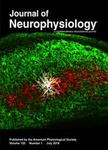版权所有:内蒙古大学图书馆 技术提供:维普资讯• 智图
内蒙古自治区呼和浩特市赛罕区大学西街235号 邮编: 010021

作者机构:New York Med Coll Dept Physiol Valhalla NY 10595 USA NYU Sch Med Dept Biochem New York NY 10016 USA NYU Sch Med Dept Physiol & Neurosci New York NY 10016 USA
出 版 物:《JOURNAL OF NEUROPHYSIOLOGY》 (神经生理学杂志)
年 卷 期:1999年第82卷第5期
页 面:2476-2489页
核心收录:
学科分类:0710[理学-生物学] 1001[医学-基础医学(可授医学、理学学位)] 07[理学] 071003[理学-生理学]
基 金:NINDS NIH HHS [NS27881 NS35215] Funding Source: Medline
主 题:动作电位/药物作用 动作电位/生理学 诱发电位 海马/生理学 中间神经元/药物作用 中间神经元/生理学 小鼠 近交C57BL 新皮质/生理学 神经元/药物作用 神经元/生理学 神经肽类/药物作用 神经肽类/生理学 钾通道/药物作用 钾通道/生理学 钾通道 电压门控 反应时间 回归分析 Shaw钾通道 躯体感觉皮质/药物作用 躯体感觉皮质/生理学 四乙基铵/药理学 动物 小鼠
摘 要:Function of specific K+ channels in sustained high-frequency firing of fast-spiking neocortical interneurons. J. Neurophysiol. 82: 2476-2489, 1999. Fast-spiking GABAergic interneurons of the neocortex and hippocampus fire high-frequency trains of brief action potentials with little spike-frequency adaptation. How these striking properties arise is unclear, although recent evidence suggests K+ channels containing Kv3.1-Kv3.2 proteins play an important role. We investigated the role of these channels in the firing properties of fast-spiking neocortical interneurons from mouse somatosensory cortex using a pharmacological and modeling approach. Low tetraethylammonium (TEA) concentrations (less than or equal to 1 mM), which block only a few known K+ channels including Kv3.1-Kv3.2, profoundly impaired action potential repolarization and high-frequency firing. Analysis of the spike trains evoked by steady depolarization revealed that, although TEA had little effect on the initial firing rate, it strongly reduced firing frequency later in the trains. These effects appeared to be specific to Kv3.1 and Kv3.2 channels, because blockade of dendrotoxin-sensitive Kv1 channels and BK Ca2+-activated K+ channels, which also have high TEA sensitivity, produced opposite or no effects. Voltage-clamp experiments confirmed the presence of a Kv3.1-Kv3.2-like current in fast-spiking neurons, but not in other interneurons. Analysis of spike shape changes during the spike trains suggested that Naf channel inactivation plays a significant role in the firing-rate slowdown produced by TEA, a conclusion that was supported by computer simulations. These findings indicate that the unique properties of Kv3.1-Kv3.2 channels enable sustained high-frequency firing by facilitating the recovery of Na+ channel inactivation and by minimizing the duration of the afterhyperpolarization in neocortical interneurons.